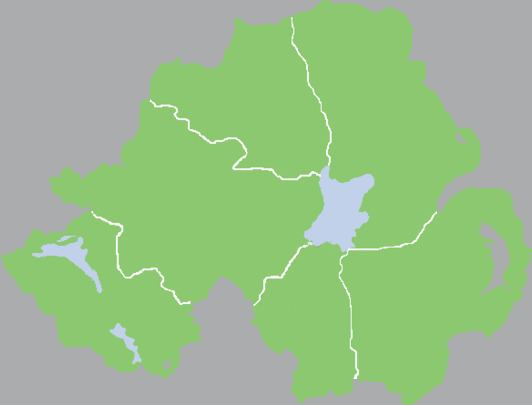 | ||
The culture of Northern Ireland relates to the traditions of Northern Ireland. Elements of the culture of Ulster and the culture of the United Kingdom are to be found.
Contents
Heritage
Since 1998, the Ulster Museum, Armagh Museum, Ulster Folk and Transport Museum and the Ulster American Folk Park have been administered by the National Museums and Galleries of Northern Ireland.
The Linen Hall Library, the oldest library in Belfast, has endured many changes of fortune since its foundation in 1788, but has maintained a vision of providing access to literature and local studies to the population at large.
Food and drink
Northern Ireland's best known chefs include Paul Rankin and Michael Deane.
The best known traditional dish in Northern Ireland is the Ulster fry. Two other popular meals are fish and chips or 'Bangers and Mash' (Sausages and Creamed Potatoes)
A unique speciality to Northern Ireland is Yellowman. Yellowman is a chewy toffee-textured honeycomb and is sold in non-standard blocks and chips and is associated with the Ould Lammas Fair in Ballycastle, County Antrim, where it is sold along with other confectionery and often dulse.
Dulse is commonly used in Ireland, where it can be used to make white soda bread. It can be found in many health food stores or fish markets and can be ordered directly from local distributors. it is also traditionally sold at the Ould Lammas Fair. It is particularly popular along the Causeway Coast. Although a fast-dying tradition, many gather their own dulse. Along the Ulster coastline from County Down to County Donegal in the Republic of Ireland, it is eaten dried and uncooked as a snack.
Languages
English is the most spoken language in Northern Ireland. There are also two recognised regional languages in Northern Ireland: the Irish language (see Irish language in Northern Ireland) and the local variety of Scots known as Ulster Scots. Northern Ireland Sign Language and Irish Sign Language have been recognised since 29 March 2004. A third, British Sign Language is also used.
At the 2001 census, Chinese was the most widely spoken minority language in Northern Ireland, with Shelta, Arabic and Portuguese also spoken by a significant number of people. Since the census, however, an influx of people from recent EU accession states is likely to have significantly increased numbers of speakers of languages from these countries. Detailed figures on these changes are not yet available.
Sports
Some team sports are played on an all-Ireland basis, while in others Northern Ireland fields its own team.
Internationally well-known sports people include:
Literature
Despite its small geographical size, Northern Ireland prolifically produces internationally renowned writers and poets from a wide variety of disciplines. Irish language literature was the predominant literature in the pre-Plantation period. The Ulster Cycle is pertinent to the history of literature in the territory of present-day Northern Ireland. Ulster Scots literature first followed models from Scotland, with the rhyming weavers, such as James Orr, developing an indigenous tradition of vernacular literature. Writers in the counties which now form Northern Ireland participated in the Gaelic Revival.
Noted visual artists from Northern Ireland include:
Performing arts
Noted actors from Northern Ireland include:
Film and television
See also Cinema of Northern Ireland
Northern Ireland Screen, a government agency financed by Invest NI and the European Regional Development Fund, provides financial support to film and television productions in Northern Ireland. Among the works it has supported is the 2011 HBO television series Game of Thrones, which is filmed principally in Belfast's Paint Hall studios and on location elsewhere in Northern Ireland.
Belfast hosts the Belfast Film Festival and the CineMagic film festival, as well as several independent cinemas including Queen's Film Theatre and Strand Cinema.
Music
Noted musicians from Northern Ireland include:
Craft
August Craft Month is an annual coordinated programme of events that showcase the work of craft makers in Northern Ireland and from across the United Kingdom, Ireland and Europe. It is organised by Craft Northern Ireland.
Songs
Traditional songs commonly associated with Northern Ireland, and Belfast in particular would be I'll Tell Me Ma and Mickey Marley's Roundabout.
A traditional song of the Unionist and Loyalist communities would be The Sash, which may be considered offensive or at least distateful by the Nationalist communities, particularly when it is used to threaten or incite violence.
Symbolism and traditions
Unionists tend to use the Union Flag and sometimes the Ulster Banner, while nationalists usually use the Flag of Ireland, or sometimes the Flag of Ulster. Both sides also occasionally use the flags of secular and religious organisations they belong to. Some groups, including the Irish Rugby Football Union and the Church of Ireland use the Flag of St. Patrick as a symbol of Ireland which lacks the same nationalist or unionist connotations.
The flax flower, representing the linen industry, has been used as a neutral symbol – as for the Northern Ireland Assembly.
St. Patrick's Day is celebrated by both nationalists and unionists, while "The Twelfth" is celebrated only by unionists.
Celebrations to mark the anniversary of the Battle of the Boyne are held every Twelfth of July and draw huge crowds. The Apprentice Boys of Derry also organise commemorative events. The bowler hat is a symbol of Orangeism.
